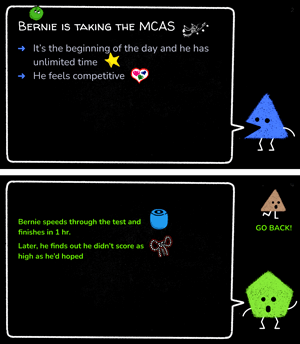Secure Checkout. FREE SHIPPING for Continental U.S. Orders over $60.
Menu
-
- Home
-
About Us
-
The Approach
-
Linking Language & Literacy
-
MindWing Learning
-
Learning Resources
-
SHOP
-
Blog
-
- About MindWing
- Our People
- Contact Us
- Your Account
- Login
-
United States (USD $)



 We have previously discussed in this blog the importance of the “GIVE A STORY TO GET A STORY” technique. Described by Hadley (1998) in her wonderful article on naturalistic language sampling, and linked to other resources, conversational mapping involves providing a story about your own life which can help elicit the same from your students. This technique provides a great model and also a pragmatic context for narrative intervention, no matter the “size” of your story. Recently, I had a rather big story to share with my students. After many years of trying, I made it through the audition process to compete on Jeopardy!...
We have previously discussed in this blog the importance of the “GIVE A STORY TO GET A STORY” technique. Described by Hadley (1998) in her wonderful article on naturalistic language sampling, and linked to other resources, conversational mapping involves providing a story about your own life which can help elicit the same from your students. This technique provides a great model and also a pragmatic context for narrative intervention, no matter the “size” of your story. Recently, I had a rather big story to share with my students. After many years of trying, I made it through the audition process to compete on Jeopardy!...




 Halloween is always a holiday that can be leveraged for engagement (and stories!) with our students.
Halloween is always a holiday that can be leveraged for engagement (and stories!) with our students.
 In this, our last entry in 2021’s Summer Study Series, we’ll review a recent article from leaders in the field who present a very helpful set of 10 principles for narrative intervention that will guide you in this new school year. Additionally, several strategies for leveraging technology will also be described, as we can consider tech a useful tool, however your service delivery evolves in this unfortunately still-weird educational situation. Spencer and Peterson (2020) detail narrative intervention principles and practice tips in their ASHA-accessible article “
In this, our last entry in 2021’s Summer Study Series, we’ll review a recent article from leaders in the field who present a very helpful set of 10 principles for narrative intervention that will guide you in this new school year. Additionally, several strategies for leveraging technology will also be described, as we can consider tech a useful tool, however your service delivery evolves in this unfortunately still-weird educational situation. Spencer and Peterson (2020) detail narrative intervention principles and practice tips in their ASHA-accessible article “